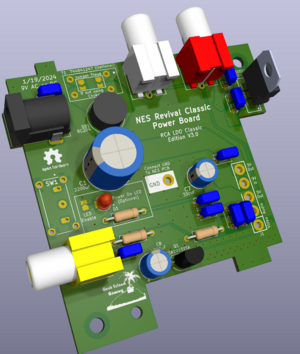NES:NESRevival-PSU: Difference between revisions
No edit summary |
No edit summary |
||
| Line 1: | Line 1: | ||
[[File:NES Revival Board.png|alt=NES Revival Board|thumb|NES Revival Board]] | [[File:NES Revival Board.png|alt=NES Revival Board|thumb|NES Revival Board]] | ||
Originally created by Merlin Shaw, the [https://github.com/ | Originally created by Merlin Shaw, the [https://github.com/Alchme/ArtemisPower-NESRevival-Power-Module NESRevival power supply board] project has been handed over to Alchme and Guardians_projects. The goal of the project is to completely Redesigning the NES Power Module to Reduce Noise and EMI. The original NES Power Module is very noisy, the power traces cross each other and the ground home path is messy. EMI was not a worry in 1985 but noise can impact picture and sound quality. Instead, we can improve it with the best of modern engineering, with classic hardware. | ||
You can find ways to manufacture and source the boards over on the project GitHub if interested. | You can find ways to manufacture and source the boards over on the project GitHub if interested. | ||
== About the Project == | |||
There have been many improvements over time with even safety features being added to allow extra tolerance in the design for faults | There have been many improvements over time with even safety features being added to allow extra tolerance in the design for faults. The project is open, and design improvements are welcomed. | ||
The project is open sourced using the MIT License. It can be edited, changed and sold at your own discretion. | The project is open sourced using the MIT License. It can be edited, changed and, sold at your own discretion. However, the author requests a link back to the original GitHub if this helps you with your own project. | ||
== Goals with these new NES Power Modules == | |||
* Full Ground Plane that is uninterrupted and is free of traces and components. | * Full Ground Plane that is uninterrupted and is free of traces and components. | ||
* Power Traces that do not cross and have the GND plane below for a good return power signal. | * Power Traces that do not cross and have the GND plane below for a good return power signal. | ||
* Have a specific NES Power Module for each use case (not try and pile everything into one board) | * Have a specific NES Power Module for each use case (to not try and pile everything into one board). | ||
* Keeping units in stock, allowing for repairs to exist in 2023. Many success stories so far to share, and hopefully more to come. | * Keeping units in stock, allowing for repairs to exist in 2023. Many success stories so far to share, and hopefully more to come. | ||
* Updated installation instructions, including | * Updated installation instructions, including part assembly content from the manufacturer | ||
Revision as of 02:19, 13 February 2024
Originally created by Merlin Shaw, the NESRevival power supply board project has been handed over to Alchme and Guardians_projects. The goal of the project is to completely Redesigning the NES Power Module to Reduce Noise and EMI. The original NES Power Module is very noisy, the power traces cross each other and the ground home path is messy. EMI was not a worry in 1985 but noise can impact picture and sound quality. Instead, we can improve it with the best of modern engineering, with classic hardware.
You can find ways to manufacture and source the boards over on the project GitHub if interested.
About the Project
There have been many improvements over time with even safety features being added to allow extra tolerance in the design for faults. The project is open, and design improvements are welcomed.
The project is open sourced using the MIT License. It can be edited, changed and, sold at your own discretion. However, the author requests a link back to the original GitHub if this helps you with your own project.
Goals with these new NES Power Modules
- Full Ground Plane that is uninterrupted and is free of traces and components.
- Power Traces that do not cross and have the GND plane below for a good return power signal.
- Have a specific NES Power Module for each use case (to not try and pile everything into one board).
- Keeping units in stock, allowing for repairs to exist in 2023. Many success stories so far to share, and hopefully more to come.
- Updated installation instructions, including part assembly content from the manufacturer
